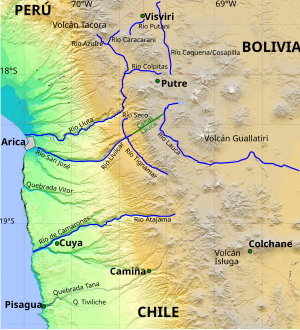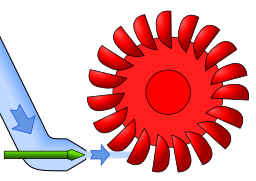| Chapiquiña Power Plant | |
|---|---|
 Scheme of the rivers in Arica y Parinacota, with Canal Lauca highlighted; the plant lies at the south-west end of the canal Scheme of the rivers in Arica y Parinacota, with Canal Lauca highlighted; the plant lies at the south-west end of the canal | |
| Official name | Central Hidroeléctrica Chapiquiña |
| Country | Chile |
| Location | Arica y Parinacota Region |
| Coordinates | 18°22′22.8″S 69°33′18″W / 18.373000°S 69.55500°W / -18.373000; -69.55500 |
| Status | Active |
| Construction began | 1962 |
| Commission date | 1967 |
| Owner | E-CL |
| Operator |
|
| Power generation | |
| Units operational | 2 |
| Nameplate capacity | 10.2 MW |
| Annual net output | 44 GW·h |
| [edit on Wikidata] | |
Chapiquiña power plant is a hydroelectric power plant in northern Chile. It takes water from the Canal Lauca and produces electrical power through a Pelton turbine.
Structure
| External image | |
|---|---|
| Chapiquiña power plant | |
It lies 120 kilometres (75 mi) east of Arica, in the Putre commune of the Arica y Parinacota Region. The plant lies at an elevation of 3,300 metres (10,800 ft); the town of Chapiquiña lies south of the plant. The name Chapiquiña is derived from Aymara ch`apikiña and means "bed of thorns".
Water is carried by the 28 kilometres (17 mi) long Canal Lauca to the plant and drops over a distance of 1,008 metres (3,307 ft) to produce electrical power through two 5.1 megawatt Pelton turbines. The water is held in a reservoir after exiting the plant before being discharged into the Quebrada Cosapilla; from there it flows into the Rio Seco and eventually into the San José River. The maximum flow capacity of the plant is 137 cubic metres per second (4,800 cu ft/s) while the capacity of the feeder Canal Lauca is only 2,750 litres per second (97 cu ft/s) and a more typical flow rate is 670 litres per second (24 cu ft/s); most of the water in the San José River comes from the Chapiquiña power plant. There is also a rain gauging station at Chapiquiña.
Operation
Chapiquiña produces about 10.2 megawatt of power which is injected into the Sistema Interconectado del Norte Grande, the regional power grid, through the Águila substation farther west. In 2013 the plant generated almost 44 GWh. It operates mainly when power consumption is high and is one of the few hydroelectric power plants in northern Chile.
Aside from producing electrical power, the water discharged into the San Jose River is intercepted downriver and used to irrigate the Azapa Valley; the reservoir downstream of the turbines serves to secure water delivery even when water is low in the Canal Lauca.
History
Studies on the possibility to use the Lauca River as a water source for the Azapa Valley were made after 1945; during planning of the diversion the idea rose to use the drop at Chapiquiña for hydropower generation. Construction of the plant was started by the company ENDESA in 1962 and operations commenced in March 1967. Until 2017, it was the largest public works project in the Arica y Parinacota Region; the construction of the power plant was part of a series of public work projects in the 1960s–1970s in the Arica region. The plant underwent a number of ownership changes after it was built; it is currently owned by the company E-CL.
It was also planned to augment the water supply to the plant by pumping water from Lake Chungara, but in 1985 the Supreme Court of Chile disallowed such pumping for environmental reasons as Lake Chungara is located in the Lauca National Park. In 2012, the Spanish ambassador Iñigo de Palacio visited the plant; in the same year quenoa woodlands began to be planted in initially about 2 hectares (4.9 acres) land owned by the plant as a conservation measure. Such trees provide nesting sites for birds and regulate the local water balance.
Notes
- Such high power production is only possible with a minimum flow of 1.2 cubic metres per second (42 cu ft/s) and thus does not occur during low flow periods.
References
- ^ "Central Hidroeléctrica en Arica genera 10,2 MW de potencia directa para el SING". Míneria Chilena (in Spanish). ELECTRICIDAD. June 5, 2012. Retrieved November 3, 2018.
- ^ "CATASTRO DE PROYECTOS Y CENTRALES DE ERNC 2014" (PDF) (in Spanish). Electricidad. 2016. p. 178. Archived from the original (PDF) on June 22, 2017. Retrieved November 3, 2018.
- ^ "Embajador de España visitó generadora hidroeléctrica Chapiquiña en región de Arica y Parinacota" [Spanish ambassador visited the Chapiquiña hydroelectric plant in the Arica y Parinacota Region]. BioBioChile (Press release) (in Spanish). March 16, 2012. Retrieved November 3, 2018.
- ^ "Chapiquiña". La Estrella de Arica (in Spanish). February 5, 2011. Retrieved November 3, 2018.
- ^ Superintendencia de Electricidad y Combustibles 2016, p. 7.
- ^ del Canto 1997, p. 23.
- ^ Jeria 2003, p. 29.
- del Canto 1997, p. 11.
- Jeria 2003, p. 30.
- Superintendencia de Electricidad y Combustibles 2016, p. 13.
- Superintendencia de Electricidad y Combustibles 2016, p. 8.
- del Canto 1997, p. 24.
- Jeria 2003, p. 27.
- ^ Peters, Ricardo (2016). "Información de parámetros de las Unidades Charmilles de Central Hidroeléctrica Chapiquiña según Anexo Técnico "Determinación de Parámetros para los Procesos de Partida y Detención de Unidades Generadoras"". Coordinador Eléctrico Nacional – SING (in Spanish). p. 2. Retrieved November 3, 2018.
- "Comienza a operar el mayor paso fronterizo integrado con Bolivia". Economía y Negocios (in Spanish). August 30, 2017. Retrieved November 3, 2018.
- Quiroz Thompson, Diego; Díaz Araya, Alberto; Galdames Rosas, Luis; Ruz Zagal, Rodrigo (2011). "Campesinos andinos y políticas agrarias durante la Junta de Adelanto de Arica (Azapa, Lluta y la precordillera, 1959–1976)". Idesia (Arica). 29 (2): 157–168. doi:10.4067/S0718-34292011000200021. ISSN 0718-3429.
- Yunge, José Manuel Borquez (1993). Introducción al derecho ambiental chileno y comparado (in Spanish). Editorial Jurídica de Chile. pp. 15–16. ISBN 9789561010093.
Sources
- del Canto, Luis Arrau (1997). "Modelo de simulación hidrológico operacional cuenca del río San José" (PDF) (in Spanish). Direccíon General de Aguas. Retrieved November 3, 2018.
- Jeria, Julio Sandoval (2003). "EL RIEGO EN CHILE" (PDF) (in Spanish). Dirección de Obras Hidráulicas. Archived from the original (PDF) on October 25, 2018. Retrieved November 3, 2018.
- Superintendencia de Electricidad y Combustibles (May 10, 2016). "INDUSTRIA ENERGÉTICA EN LA REGIÓN" (PDF). Superintendencia de Electricidad y Combustibles (in Spanish). Retrieved November 3, 2018.
External links
Ulloa Alvarado, Andrés Camilo (2016). Análisis preliminar de la conversión de una central hidroeléctrica convencional en una de bombeo. Caso Central Chapiquiña, Región de Arica y Parinacota, Chile (Thesis) (in Spanish). University of Chile.
| Energy in Chile | |||||||||||||||||
|---|---|---|---|---|---|---|---|---|---|---|---|---|---|---|---|---|---|
| Companies | |||||||||||||||||
| Power grids | |||||||||||||||||
| Power plants |
| ||||||||||||||||
| Category:Energy in Chile | |||||||||||||||||

